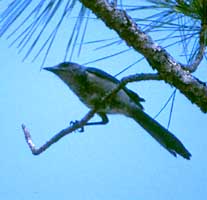
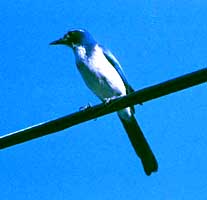
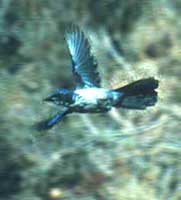
SCRUB-JAYS Aphelocoma
discussion & photos by Don Roberson
The three scrub-jay of North America do not present much of a practical
identification problem because they are entirely allopatric in distribution
(i.e., their ranges never overlap), but since I have a series of photos
of each, it might be fun to compare them side-by-side. Unfortunately, all
of my shots of Western Scrub-Jay A. californica are of the coastal
birds (nominate race), and I cannot show the interior "Woodhouse's Scrub-Jay"
A.
c. woodhouseii that might also someday be considered a separate species.
It was not long ago when the three taxa shown here were considered all
the same species; there are obviously many similarities between the Florida
Scrub-Jay A. coerulescens (top left), the Western Scrub-Jay (top
center), and the Island Scrub-Jay A. insularis (top right). These
three taxa had been considered simply races of a single North American
species since Pitelka's (1951) classic study, but biochemical analysis
(Peterson 1992) convinced the A.O.U. to split them into three species in
1995 consistent with changing understandings of what constitutes a "species"
within the biological species concept. The discussion here is not meant
to be a comprehensive analysis of the identification of these groups. Rather,
we will simply compare some photos and talk in generalities. Some other
comparative pieces -- with photos -- have been published elsewhere (e.g.,
DeBenedictis 1994).
Let's start with the familiar western North American bird, the Western
Scrub-Jay (below). It is a bright & contrasty bird. It is very
common in coastal California, particular in any deciduous woodlands (oak
woodlands are perfect), but its range is widespread in the western U.S.
(beware that interior birds appear more "washed-out" and may even be on
their way to specific status; however, there apparently in some interbreeding
between these groups; Peterson 1991).
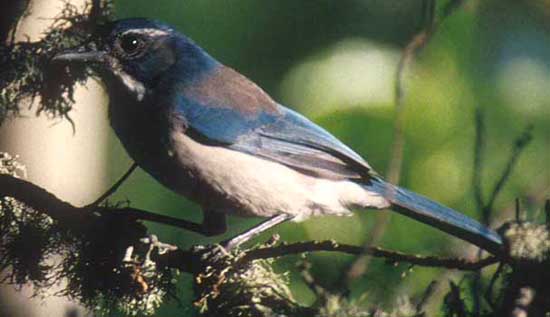
Note the strong tone of the blue color, the contrasting grayish-brown
back, and the well-defined white supercilium behind the eye. There is an
obvious "necklace" of blue across the breast, perhaps seen better in the
small top middle photo than the larger shot (which has shadow across the
breast). The bill is moderately hefty.
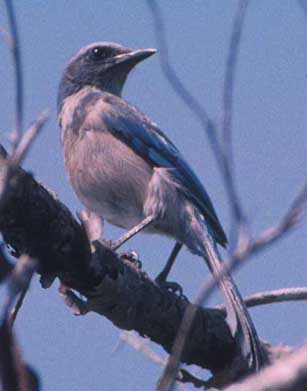
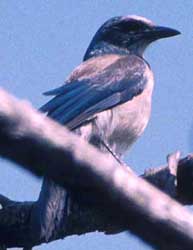 In general, the Florida Scrub-Jay (left and above) is the "washed-out"
version in the group (but beware than Great Basin "Woodhouse's Jays" also
look much paler than coastal California birds). The back is gray without
any brown tones. It lacks a white supercilium and, instead, has a frosty
white forecrown (which includes the supercilium area in front of the eye).
The underparts are washed with a dingy gray (the other scrub-jays are essentially
clean white below); some texts use the term "streaking" but I thought the
underparts simply "muddy" and not streaked. The bill is comparatively small
(but broad) for this group. Fledgling Western Scrub-Jay in mid-summer in
California are more washed-out than adults, and especially about the head,
but never show a decidedly white forehead like the Florida birds. Florida
Scub-Jays also have blue undertail coverts, unlike coastal Western Scrub-Jay
whose undertail coverts are white (but interior Western Scrub-Jays may
show blue undertail coverts). The Florida birds have somewhat different
proportions, being especially long-tailed (compare left & center photos
at the top of the page). While their calls are well within typical "scrub-jay"
repertoire (and I recognized a "scrub-jay" at a distance in a recent Florida
visit, leading to these photos), the vocalizations were also different
than those of California Scrub-Jays in my backyard, but I can't quite put
my finger on what the difference was (the National Geographic field
guide uses the words "raspy" and "hoarse" but my feeling was something
a bit more musical).
In general, the Florida Scrub-Jay (left and above) is the "washed-out"
version in the group (but beware than Great Basin "Woodhouse's Jays" also
look much paler than coastal California birds). The back is gray without
any brown tones. It lacks a white supercilium and, instead, has a frosty
white forecrown (which includes the supercilium area in front of the eye).
The underparts are washed with a dingy gray (the other scrub-jays are essentially
clean white below); some texts use the term "streaking" but I thought the
underparts simply "muddy" and not streaked. The bill is comparatively small
(but broad) for this group. Fledgling Western Scrub-Jay in mid-summer in
California are more washed-out than adults, and especially about the head,
but never show a decidedly white forehead like the Florida birds. Florida
Scub-Jays also have blue undertail coverts, unlike coastal Western Scrub-Jay
whose undertail coverts are white (but interior Western Scrub-Jays may
show blue undertail coverts). The Florida birds have somewhat different
proportions, being especially long-tailed (compare left & center photos
at the top of the page). While their calls are well within typical "scrub-jay"
repertoire (and I recognized a "scrub-jay" at a distance in a recent Florida
visit, leading to these photos), the vocalizations were also different
than those of California Scrub-Jays in my backyard, but I can't quite put
my finger on what the difference was (the National Geographic field
guide uses the words "raspy" and "hoarse" but my feeling was something
a bit more musical).
Florida Scub-Jays have seriously declined in recent decades, with losses
at perhaps 80% of the population. They are restricted to a successional
habitat caused by fire, and are now known from rather isolated pockets
across central Florida. The differ from other scrub-jays in cooperative
breeding; much study of their life history has been published (see especially
Woolfenden & Fitzpatrick 1984).
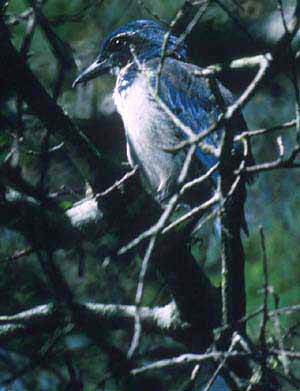 The
Island
Scrub-Jay (right) is obviously closely related to Western Scrub-Jay,
and shares the bright & contrasty plumage. If anything it is brighter
and darker above with an even browner back. It averages considerably larger
and than the mainland jay, and has proportionally heavier legs and feet.
There is more sexual dimorphism with males having much heavier bills than
females (this photo is probably of a male). Big-billed birds like this
one could be identified on bill size alone, but the smaller-billed females
overlap in size with coastal mainland Western Scrub-Jays (there was a photo
quiz on this point on Joe
Morlan's web site back in December 1999). The Island Scrub-Jay has
blue undertail coverts (see the flight photo top right at the top of the
page), while coastal Western Scrub-Jays have white ones (but recall that
interior Western Scrub-Jays may have blue undertail coverts; however, these
birds are not nearly as dark or contrasting as Island Scrub-Jay). Another
useful point is the forehead color right above the bill: concolorous blue
on Western Scrub-Jay but often darker or even blackish on Island Scrub-Jay.
Both Western and Island scrub-jays have contrasting white superciliums
that start above the eye and continue rearwards.
The
Island
Scrub-Jay (right) is obviously closely related to Western Scrub-Jay,
and shares the bright & contrasty plumage. If anything it is brighter
and darker above with an even browner back. It averages considerably larger
and than the mainland jay, and has proportionally heavier legs and feet.
There is more sexual dimorphism with males having much heavier bills than
females (this photo is probably of a male). Big-billed birds like this
one could be identified on bill size alone, but the smaller-billed females
overlap in size with coastal mainland Western Scrub-Jays (there was a photo
quiz on this point on Joe
Morlan's web site back in December 1999). The Island Scrub-Jay has
blue undertail coverts (see the flight photo top right at the top of the
page), while coastal Western Scrub-Jays have white ones (but recall that
interior Western Scrub-Jays may have blue undertail coverts; however, these
birds are not nearly as dark or contrasting as Island Scrub-Jay). Another
useful point is the forehead color right above the bill: concolorous blue
on Western Scrub-Jay but often darker or even blackish on Island Scrub-Jay.
Both Western and Island scrub-jays have contrasting white superciliums
that start above the eye and continue rearwards.
The Island Scrub-Jay is entirely endemic to Santa Cruz Island in the
Channel Islands off southern California where its life history is similar
to that of Western Scrub-Jay. An excellent summary popular article on Island
Scrub-Jay (with color photos), including details of its life history and
ecology, is in Atwood & Collins (1997). They also give information
on how birders may reach the island and find the jay.
Joe Morlan has pointed out that the plate in the National Geographic
guide incorrectly suggests that the breast band is solid on the Island
Scrub-Jay and broken on the Western Scrub-Jay. In fact, there is no such
difference. As shown on the photos below, the breastband of each species
can overlap the pattern of the others. Note, however, forehead coloration
in these shots: whitish in Florida Scrub-Jay (left), uniform blue in Western
Scrub-Jay (center), and darker blue in Island Scrub-Jay (right) with the
black of the lores extending up into the distal portion of the forecrown.
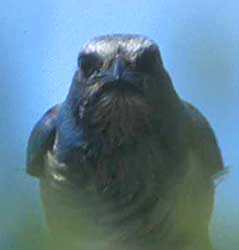
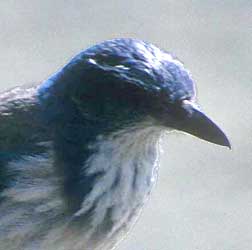
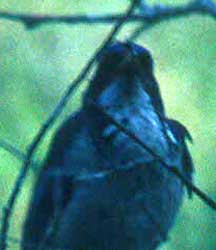
PHOTOS: The Florida Scrub-Jay
photos were all taken 21 Apr 2000 at Jonathan Dickinson State Park near
Hobie Sound, Florida; it took us several hours to finally locate a small
group. The Island Scrub-Jay shots were all
taken 17 Aug 1992 on Santa Cruz I., California. The Western
Scrub-Jay images are from Monterey County, California. The small
top center one was in Pacific Grove 14 Nov 1979; the large photo at Pt.
Pinos 27 Sep 1998, and the bottom center one from Big Sur 22 June 1997.
Another Western Scrub-Jay photo from my yard is on-line on my "Corvid
Family" page.
Literature Cited:
Atwood, J. L., and C. T. Collins. 1997. The Island Scrub-Jay:
origins, behavior, and ecology. Birding 29: 476-485.
DeBenedictis, P. A. 1994. Gleanings for the technical literature: Aphelocoma
jays. Birding 26: 195-198.
Peterson, A. T. 1991. Gene flow in scrub jays: frequency and direction
of movement. Condor 93: 935-942.
Peterson, A. T. 1992. Phylogeny and rates of molecular evolution in
the Aphelocoma jays (Corvidae). Auk 109: 133-147.
Pitelka, F. A. 1951. Speciation and ecologic distribution of American
jays of the genus Aphelocoma. Univ. Calif. Publ. Zool. 50: 195-464.
Woolfenden, G. E., and J. W. Fitzpatrick. 1984. The Florida Scrub-Jay:
Demography of a Cooperative Breeding Bird. Monograph in Population Biology
No. 20. Princeton Univ. Press, Princeton, New Jersey.
TOP
BACK TO HOME
PAGE
BACK TO IDENTIFICATION
PAGE
TO LIST OF BIRD
FAMILIES OF THE WORLD
Page created 22-30 July 2000





 In general, the Florida Scrub-Jay (left and above) is the "washed-out"
version in the group (but beware than Great Basin "Woodhouse's Jays" also
look much paler than coastal California birds). The back is gray without
any brown tones. It lacks a white supercilium and, instead, has a frosty
white forecrown (which includes the supercilium area in front of the eye).
The underparts are washed with a dingy gray (the other scrub-jays are essentially
clean white below); some texts use the term "streaking" but I thought the
underparts simply "muddy" and not streaked. The bill is comparatively small
(but broad) for this group. Fledgling Western Scrub-Jay in mid-summer in
California are more washed-out than adults, and especially about the head,
but never show a decidedly white forehead like the Florida birds. Florida
Scub-Jays also have blue undertail coverts, unlike coastal Western Scrub-Jay
whose undertail coverts are white (but interior Western Scrub-Jays may
show blue undertail coverts). The Florida birds have somewhat different
proportions, being especially long-tailed (compare left & center photos
at the top of the page). While their calls are well within typical "scrub-jay"
repertoire (and I recognized a "scrub-jay" at a distance in a recent Florida
visit, leading to these photos), the vocalizations were also different
than those of California Scrub-Jays in my backyard, but I can't quite put
my finger on what the difference was (the National Geographic field
guide uses the words "raspy" and "hoarse" but my feeling was something
a bit more musical).
In general, the Florida Scrub-Jay (left and above) is the "washed-out"
version in the group (but beware than Great Basin "Woodhouse's Jays" also
look much paler than coastal California birds). The back is gray without
any brown tones. It lacks a white supercilium and, instead, has a frosty
white forecrown (which includes the supercilium area in front of the eye).
The underparts are washed with a dingy gray (the other scrub-jays are essentially
clean white below); some texts use the term "streaking" but I thought the
underparts simply "muddy" and not streaked. The bill is comparatively small
(but broad) for this group. Fledgling Western Scrub-Jay in mid-summer in
California are more washed-out than adults, and especially about the head,
but never show a decidedly white forehead like the Florida birds. Florida
Scub-Jays also have blue undertail coverts, unlike coastal Western Scrub-Jay
whose undertail coverts are white (but interior Western Scrub-Jays may
show blue undertail coverts). The Florida birds have somewhat different
proportions, being especially long-tailed (compare left & center photos
at the top of the page). While their calls are well within typical "scrub-jay"
repertoire (and I recognized a "scrub-jay" at a distance in a recent Florida
visit, leading to these photos), the vocalizations were also different
than those of California Scrub-Jays in my backyard, but I can't quite put
my finger on what the difference was (the National Geographic field
guide uses the words "raspy" and "hoarse" but my feeling was something
a bit more musical).
 The
Island
Scrub-Jay (right) is obviously closely related to Western Scrub-Jay,
and shares the bright & contrasty plumage. If anything it is brighter
and darker above with an even browner back. It averages considerably larger
and than the mainland jay, and has proportionally heavier legs and feet.
There is more sexual dimorphism with males having much heavier bills than
females (this photo is probably of a male). Big-billed birds like this
one could be identified on bill size alone, but the smaller-billed females
overlap in size with coastal mainland Western Scrub-Jays (there was a photo
quiz on this point on
The
Island
Scrub-Jay (right) is obviously closely related to Western Scrub-Jay,
and shares the bright & contrasty plumage. If anything it is brighter
and darker above with an even browner back. It averages considerably larger
and than the mainland jay, and has proportionally heavier legs and feet.
There is more sexual dimorphism with males having much heavier bills than
females (this photo is probably of a male). Big-billed birds like this
one could be identified on bill size alone, but the smaller-billed females
overlap in size with coastal mainland Western Scrub-Jays (there was a photo
quiz on this point on 

